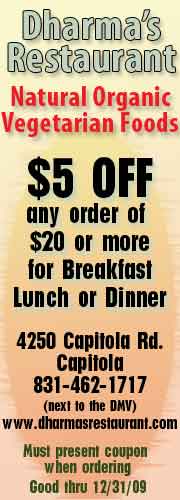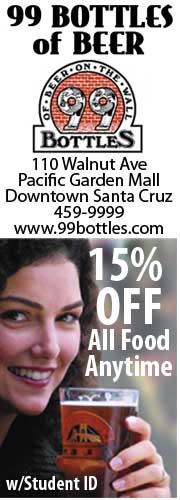Dining
Living the Meat-Free Life
One person's decision
By Kent Klee
 If you were raised anywhere outside of Santa Cruz, chances are beef wasn’t just for dinner. It was probably for breakfast and lunch, too, with a side of sausage and fried chicken.
If you were raised anywhere outside of Santa Cruz, chances are beef wasn’t just for dinner. It was probably for breakfast and lunch, too, with a side of sausage and fried chicken.Meat is everywhere. It’s easy as fast food and the centerpiece in most American cuisines. Still, it seems like more people are choosing to not eat meat. For me it happened when some clever activists snuck a video camera into a slaughterhouse. The few seconds of footage I could watch confirmed the kinds of cruelties I had always thought happened but never really confronted. But the reason why anybody chooses to stop eating animals is not important. What’s important is that when somebody makes the decision, it’s a decision he or she can actually stick to.
If you’re going veg, the first thing to do is to really know why you’re doing it. The reasons aren’t at all limited to the environmental and health benefits, or to simple guilt over eating animals. No reason is better than any other, but the reasons have to be personal. If you become a vegetarian to fit a lifestyle that merely includes not eating meat, once you get tired of that lifestyle (i.e., leave Santa Cruz) you’ll probably eat meat again.
One you’ve got the “why” figured out, you can decide what kind of vegetarian lifestyle fits. There are almost as many types of vegetarians as there are reasons to switch. There are semi-vegetarians like the pescotarian, who only eat fish, and the pollitarian, who eat poultry but not the darker meats. Ovo-vegetarians, don’t eat meat or dairy but will eat eggs until the chickens come home. Lacto-vegetarians don’t eat meat or eggs but are fine with milk and cheese. Vegans don’t eat anything produced from animals. There are also the hardcore types, like raw vegetarians who only eat uncooked foods and nuts, and fruitarians who only eat fruits and seeds.
Next, get a solid diet plan. Do some research online - there’s plenty of information out there. Healthwise, it’s crucial to know exactly where you’re going to get your protein. When I first gave up meat I was exercising four days a week and working a very physical full-time job. Within a couple of months, my meatless existence had started to affect my body. I felt lethargic, and my fingernails became noticeably thinner and more flexible. My hair started to thin. I hadn’t really thought about my diet before I cut out the meat, and I paid the price.
The good news is that there are more protein solutions than just tofu and beans. As I’ve never been into beans and pulses, my first experience cooking outside of tofu was with seitan, a wheat-gluten-based protein with a texture sort of like meat. It’s nice, and has a neutral taste that takes on the flavors of whatever else you cook with it. Tempeh is another high-protein soy product similar to tofu.
For repentant vegetarians, companies like Morningstar and Yves make soy hot dogs, sausages and meat-like ground textured soy protein that’s great for sloppy joes and pasta sauces. I’ve tried turkey-like deli slices in a sandwich and it wasn’t bad. For a lifetime carnivore, one of the hardest parts of cutting out meat is to replace the function of meat in your eating habits. These products try to fill that gap.
Of course, old school vegetarians argue a more purist route. Pulses and beans are, for many, worth the time and trouble to prepare. Lentils and the like have always been a healthy, traditional staple for vegetarian cultures around the world. They’re one reason Indian restaurants are such a frequent vegetarian eating ground. And don’t underestimate the power of the quinoa, which is not a grain, but related to beets. It is both very high in protein and quite tasty.
If all else fails there are what you might call alternative protein-ingestion methods. To insult the veg purists perhaps a little more than I already have, I’d suggest you consider a high-quality protein powder used by athletes. They cost around $70 monthly for a high-quality whey powder but often work fine to provide the protein your body needs.
It really doesn’t matter how you get there if your goal is to stop eating animals. And it doesn’t matter who you are. I definitely don’t fit the veg stereotype, but neither do any number of people who don’t eat meat. There’s no veg czar to say there’s a right or wrong way to do it, or a right or wrong reason. All of us make the best lifestyle decisions we can, whether that includes wearing hemp clothing, eating organic local produce (almost surely picked by underpaid migrant workers) or living vegetarian. We all have to live lives we feel good about. Beyond that, the details are really up to us.



